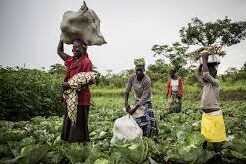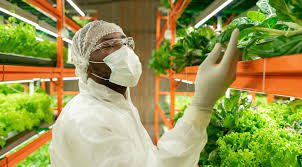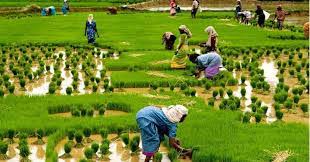Agriculture plays a vital role in the economy by providing employment, contributing to GDP, supporting food security, and generating export earnings. This article explores the various ways agriculture impacts economic development and supports communities worldwide.
Agriculture as a Source of Employment
Agriculture is a major source of employment, particularly in developing countries. It provides livelihoods for millions of people, directly and indirectly. Key points include:
1. Rural Employment: Agriculture is the primary occupation in rural areas, where many people rely on farming, livestock rearing, and related activities.
2. Seasonal Employment: Agricultural activities often create seasonal jobs, which support workers during peak planting and harvesting periods.
3. Agri-Business Opportunities: The agricultural sector generates jobs beyond the farm, including those in processing, marketing, distribution, and agricultural services.
4. Women’s Employment: Agriculture is a significant source of employment for women, who play essential roles in food production and farming activities worldwide.
5. Skill Development: Agricultural work fosters skills in farming, animal care, and crop management, which contribute to overall community development.
Contribution of Agriculture to GDP
Agriculture contributes to a country’s Gross Domestic Product (GDP), which reflects the sector’s role in economic growth. Key aspects include:
1. Value-Added Products: The agricultural sector contributes to GDP through primary production and value-added products such as processed foods.
2. Multiplier Effect: Agriculture stimulates other industries, including manufacturing and retail, leading to additional economic growth.
3. Regional Development: In many developing countries, agriculture is a critical sector for economic development, reducing regional disparities by supporting rural economies.
4. Tax Revenues: Agricultural businesses contribute to government revenues through taxes, which fund public services and infrastructure.
5. Economic Resilience: A strong agricultural sector enhances a country’s economic resilience, reducing dependence on imports and strengthening local economies.
Agriculture’s Role in Food Security

Agriculture is fundamental to food security, ensuring that communities have access to sufficient, safe, and nutritious food. Key points include:
1. Food Production: Agriculture produces a wide variety of foods essential for meeting dietary needs, including grains, vegetables, fruits, and proteins.
2. Poverty Reduction: By creating jobs and income, agriculture helps reduce poverty, enabling families to afford nutritious food.
3. Nutritional Diversity: A diverse agricultural sector supports balanced diets by providing different types of food that contribute to health and well-being.
4. Local Food Systems: Agriculture strengthens local food systems, reducing reliance on imported food and enhancing food security in remote areas.
5. Emergency Food Supply: Agriculture supports food reserves and stockpiling, which are essential for responding to emergencies and natural disasters.
Agriculture and Export Earnings
Agricultural exports are a significant source of foreign exchange for many countries, contributing to economic stability. Key contributions include:
1. Trade Balance: Agricultural exports improve the trade balance by reducing the need for imports and increasing export revenues.
2. Foreign Exchange: Agricultural exports generate foreign exchange, which is vital for purchasing essential imports such as fuel, machinery, and technology.
3. Market Expansion: By exporting agricultural products, countries can access new markets and diversify their income sources.
4. Product Specialization: Many countries specialize in certain agricultural products, such as coffee, tea, or cotton, which become significant export commodities.
5. Economic Growth: Agricultural exports drive economic growth by increasing incomes and creating jobs in agriculture, transportation, and logistics.
Impact of Agriculture on Rural Development
Agriculture is the backbone of rural development, providing livelihoods and infrastructure support. Key ways agriculture impacts rural development include:
1. Job Creation: Agriculture generates employment opportunities in rural areas, reducing rural-urban migration.
2. Infrastructure Development: Investment in agriculture often leads to improved infrastructure, such as roads, schools, and healthcare facilities.
3. Community Empowerment: Agricultural activities strengthen rural communities by promoting self-reliance and enhancing local governance.
4. Income Generation: Farming activities contribute to household incomes, improving living standards and reducing poverty.
5. Social Cohesion: Agriculture fosters social ties within communities, as people work together, share resources, and support one another.
Agriculture’s Role in Industrial Development
Agriculture supports industrial growth by supplying raw materials and creating demand for industrial products. Key contributions include:
1. Raw Material Supply: Agriculture provides essential raw materials for industries like food processing, textiles, and biofuels.
2. Market for Industrial Goods: Farmers purchase industrial goods such as machinery, fertilizers, and pesticides, boosting the manufacturing sector.
3. Agro-Processing Industries: Agriculture supports agro-processing industries that add value to raw agricultural products, creating more jobs and boosting GDP.
4. Linkages with Other Sectors: Agriculture’s linkages with other sectors stimulate economic growth, as demand for transportation, packaging, and storage facilities increases.
5. Technology Transfer: Agricultural growth encourages technology transfer, as industries innovate to meet the needs of farmers and improve productivity.
Read Also: Effects of Altitude and Soil Condition on Animal Production
The Influence of Agriculture on Trade Balance

Agriculture influences the trade balance by contributing to exports and reducing import dependency. Key points include:
1. Export Earnings: Many countries rely on agricultural exports, which improve the trade balance and generate foreign exchange.
2. Import Substitution: Agriculture reduces the need for food imports by promoting self-sufficiency and local production.
3. Diversification of Exports: By diversifying agricultural exports, countries can reduce economic risks associated with single-commodity reliance.
4. Trade Partnerships: Agricultural exports facilitate trade partnerships, strengthening international relations and expanding market access.
5. Contribution to GDP: Agricultural exports contribute to GDP, enhancing economic growth and improving the overall trade balance.
Agriculture and Raw Material Production
Agriculture provides essential raw materials for various industries, supporting economic development and diversification. Key contributions include:
1. Textile Industry: Crops like cotton and flax are vital raw materials for the textile industry, producing clothing and fabrics.
2. Food Processing: Agriculture supplies fruits, vegetables, and grains for food processing, which adds value and creates job opportunities.
3. Biofuel Production: Crops such as sugarcane and corn are used to produce biofuels, reducing reliance on fossil fuels and promoting energy security.
4. Pharmaceutical Industry: Many plants, like aloe and turmeric, are used in pharmaceuticals, contributing to health-related industries.
5. Construction Materials: Agriculture provides materials like bamboo and timber, which are used in construction and furniture-making.
The Role of Agriculture in Poverty Reduction
Agriculture plays a crucial role in poverty reduction by creating jobs, increasing incomes, and providing food security. Key ways agriculture reduces poverty include:
1. Employment Opportunities: Agriculture creates jobs for both skilled and unskilled workers, particularly in rural areas where poverty rates are high.
2. Income Generation: Farming generates income for smallholder farmers, enabling them to afford healthcare, education, and other essentials.
3. Food Security: By increasing food availability, agriculture helps reduce hunger and malnutrition, improving health and productivity.
4. Empowering Women: Agriculture provides income opportunities for women, who often reinvest earnings into family needs, promoting community development.
5. Rural Development: Agricultural growth stimulates rural development, improving access to services and reducing poverty.
Agriculture’s Impact on National Income
Agriculture is a major contributor to national income, especially in agrarian economies. It provides both direct and indirect benefits, supporting other sectors of the economy. Key ways agriculture impacts national income include:
1. Primary Production: Agriculture produces essential food and raw materials, directly adding to national income through crop and livestock production.
2. Contribution to GDP: In many countries, agriculture constitutes a significant percentage of the Gross Domestic Product (GDP), reflecting its importance to the economy.
3. Tax Revenues: Agricultural businesses and activities contribute to tax revenues, which support public services and infrastructure.
4. Export Earnings: Agriculture generates foreign exchange earnings through exports, boosting national income and supporting economic stability.
5. Job Creation: Agriculture provides employment for a large segment of the population, contributing to household incomes and reducing poverty.
Read Also: Reasons to use Rabbit Poo (Manure) for our Soil and Crops
Agriculture’s Role in Economic Stabilization

Agriculture is essential for economic stabilization, as it reduces dependency on imported food, supports price stability, and maintains rural employment. Key contributions to economic stabilization include:
1. Food Security: A stable agricultural sector ensures a reliable food supply, reducing the need for imports and stabilizing prices.
2. Inflation Control: Agriculture helps control inflation by keeping food prices steady, which is essential for economic stability.
3. Income Stability: Agricultural income provides a safety net for rural populations, especially during economic downturns.
4. Diversification: By diversifying the economy, agriculture reduces vulnerability to fluctuations in other sectors, such as manufacturing or mining.
5. Buffer Against Recessions: A strong agricultural sector can buffer the economy during recessions, as food demand remains relatively stable.
The Influence of Agriculture on Infrastructure Development
Agriculture drives infrastructure development by creating demand for roads, storage facilities, irrigation systems, and other essential facilities. Key ways agriculture influences infrastructure development include:
1. Transportation Networks: Agricultural activities require efficient transportation to move products to markets, leading to road and rail development in rural areas.
2. Irrigation Systems: To enhance productivity, agriculture promotes the construction of dams, canals, and irrigation systems, improving water access.
3. Storage Facilities: The need for proper storage of crops and livestock products drives the development of silos, warehouses, and cold storage facilities.
4. Market Facilities: Agriculture creates demand for marketplaces and rural trading centers, improving access to goods and services for local communities.
5. Energy and Utilities: Agriculture’s energy needs support the development of rural electrification, fuel distribution, and other essential utilities.
Agriculture and Technological Advancements
Agriculture has spurred technological innovations aimed at improving productivity, efficiency, and sustainability. Key technological advancements driven by agriculture include:
1. Precision Farming: Technologies such as GPS and satellite imagery help farmers monitor crops, optimize inputs, and reduce waste.
2. Biotechnology: Advances in biotechnology have led to genetically modified crops, which are more resistant to pests, diseases, and adverse weather.
3. Smart Irrigation: Smart irrigation systems conserve water by delivering precise amounts of water based on crop needs and environmental conditions.
4. Drones and Robotics: Drones and robotics are used for tasks like crop monitoring, planting, and harvesting, improving efficiency and reducing labor costs.
5. Mobile Applications: Mobile apps provide farmers with access to weather forecasts, market prices, and best practices, supporting informed decision-making.
Do you have any questions, suggestions, or contributions? If so, please feel free to use the comment box below to share your thoughts. We also encourage you to kindly share this information with others who might benefit from it. Since we can’t reach everyone at once, we truly appreciate your help in spreading the word. Thank you so much for your support and for sharing!

